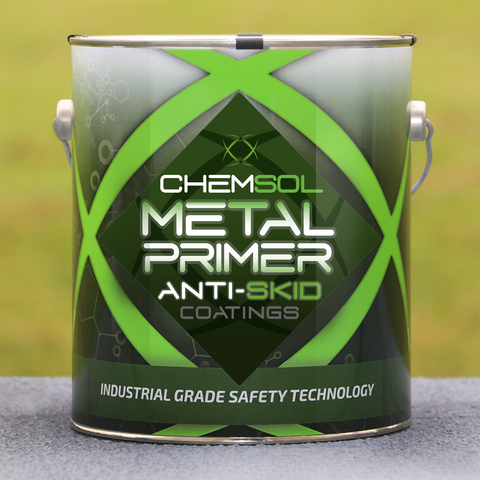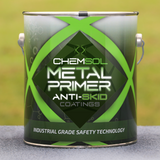Metal Primer
Chemsol Metal Primer (MP): 2-part epoxy metal primer for use with Chemsol Non-Slip coatings.
Chemsol MP is most frequently used for:
- Priming substrates prior to Chemsol Non-Slip topcoat application
- Priming metal, fiberglass, polyethylene, PVC, FRP, and other non-porous surfaces
Product Details
Description:
Chemsol Metal Primer (MP) is a two-component, high solids, fast curing solvent-based epoxy primer coating. It has been engineered to provide excellent adhesion for Chemsol Non-Slip products.
Chemsol MP is suitable for use on flooring, ramps, steps, and other areas where priming is recommended prior to application of Chemsol Non-Slip or other topcoats.
Chemsol MP is suitable for industrial, commercial, marine, and consumer environments. It is easy to apply and has very little odor which makes it ideal for use in odor-sensitive areas both indoor and outdoor. It is designed to adhere to a variety of surfaces including metal, fiberglass, polyethylene, PVC, FRP, and other surfaces. Priming is recommended for best performance of Chemsol topcoats.
Uses:
Designed for a one coat primer low-build (tight) application to porous substrates requiring priming before application of Chemsol topcoats. Suitable for both indoor and outdoor industrial, commercial, marine, and residential applications.
Advantages:
- High durability
- High adhesion to metal and other substrates
- High resistance to abrasion
Product Application:
Chemsol MP is a high technology epoxy coating that is suitable for commercial and industrial use. Thus, installation by professional epoxy installers is recommended. As with most high performance coating systems, the performance, durability, and overall efficacy of this product depends highly on correct surface preparation as well as on correct product application procedures. If surface preparation and/or application procedures are not followed, the product warranty will be voided. It is critical for proper product performance that surface preparation and application procedures are followed.
Atmospheric and General Notes:
- 24 hours prior to installation, store material between 70°F to 75°F (21°C to 24°C) for best results
- Substrate and ambient temperature should be between 70°F to 90°F (21°C to 32°C) for best results
- For best results humidity should be between 50% and 70% R.H.
- Moisture content should not exceed 3% for concrete substrates and 15% for wood substrates
- Allow for proper joints in substrates and do not overcoat joints
- Do not thin the coating
- After surface preparation and prior to applying primer, use masking tape to tape off any areas that are not to be coated. Note: pay special attention to joints, bolt holes, areas of contact or abrasion, or hinges: tape off any area that does not require coating. Important: prior to material drying, remove tape.
Surface Preparation:
Concrete: Completely remove oil, grease, dirt, and all other surface contaminants using a commercial grade cleaner/degreaser. Flush the area with water to remove any residue and allow to dry completely. Remove any paint, coating, contaminant, laitance, or loose concrete by scarification or blasting, or other mechanical means per NACE No. 6 / SSPC-SP 13 (Surface Preparation of Concrete). Smooth or glazed concrete surfaces should be roughened to improve adhesion. New concrete should be cured for at least 30 days prior to application. All release agents, hardeners, or sealers must also be removed. The concrete surface must be clean, dry, and abraded. Note: use Chemsol Waterborne Epoxy Surface Primer for concrete.
Metal: Completely remove oil, grease, dirt, and all other surface contaminants using a commercial grade cleaner/degreaser. Prepare the metal surface in accordance with NACE No. 2 / SSPC-SP 10 (Near-White Blast Cleaning). We recommend the SSPC-SP 10 standard over any type of power tool or mechanical cleaning or abrading. Galvanized (HDG) steel should be prepared in accordance with ASTM D6386. Contact Chemsol Technical Representative prior to preparing for installation on aluminum, galvanized, or specialty metals.
Wood: Completely remove oil, grease, dirt, and all other surface contaminants using a commercial grade cleaner/degreaser. Flush the area with water to remove any residues and allow to dry. Sand the surface to remove loose material and to create a surface profile for application. Ensure that surface is clean and free from saw dust and other contaminants. Wood must be dry. Note: use Chemsol Waterborne Epoxy Surface Primer for wood.
Fiberglass/PVC/FRP/Tile: Completely remove oil, grease, dirt, and all other surface contaminants using a commercial grade cleaner/degreaser. Flush the area with water to remove any residues and allow to dry. Sand/abrade the surface to remove loose material and to create a surface profile for application. Ensure that the surface is clean and free from contaminants. Note: use Chemsol Waterborne Epoxy Surface Primer for tile.
Other: Contact Chemsol Technical Representative prior to preparation or installation.
Mixing:
Do not mix more material than can be applied within the pot life.
Premix Part A separately. Always use the following mixing procedures.
Use a mechanical paint mixer, preferably a metal mixing blade attached to a hand-held drill. Do not use a paint shaker to mix the product.
Open Part A and premix Part A with the mechanical mixer. Use a moderate motor speed and avoid introducing air into Part A. Move the mix blade throughout the entire container – up and down, side to side, touching all side walls and bottom of the container, and throughout the middle of the container. Mix until a uniform consistency is achieved. This should normally take about 1 to 2 minutes.
Empty the entire contents of Part B into Part A. A paint spatula or other tool should be used to ensure that all of Part B is emptied out of the container and into Part A. Always mix the entire contents of Part B with the entire contents of Part A.
Mix the combined parts A and B with the same diligence as when premixing. Correct product performance depends on achieving a thorough mix. If the product is not mixed thoroughly, then the product may not cure properly. Use a moderate drill speed and avoid introducing air into the product. Move the mix blade throughout the entire container – up and down, side to side, touching all side walls and bottom of the container, and throughout the middle of the container. Mix until a uniform consistency is achieved. This should normally take about 3 to 5 minutes.
Application:
Apply at a spread rate of approximately 4.2 mils wft to achieve 3 mils dft (approximately 379 ft2/gallon).
Apply with brush, roller, and/or squeegee. Chemsol MP can also be applied via airless or conventional spray equipment.
General Limitations:
- Substrate Moisture Content: Moisture content of concrete substrate should not exceed 3%. For wood substrates, moisture content should not exceed 15%.
- Product Temperature: Optimum performance is achieved by preconditioning Chemsol MP for at least 24 hours between 70°F to 75°F (21°C to 24°C). Max temperature resistance once cured is 250°F.
- Ambient Temperature: Minimum 50°F (10°C); Maximum 85°F (30°C). We recommend application at temperatures at or above 70°F.
- Substrate Temperature: Minimum 50°F (10°C); Maximum 85°F (30°C); substrate temperature must be at least 5°F (3°C) above dew point.
- Relative Humidity: Maximum 85% for application and curing. High humidity will prolong curing.
- Thinning: Thinning is not recommended and will void warranty.
- Chemsol MP is intended for application by experienced professional installers only.
Chemsol warrants that its products meet its internal specifications and are of merchantable quality. However, the purchaser is solely responsible for the suitability of the product for any particular application. The purchaser should thoroughly test or qualify the product for serviceability, environmental compliance, and health and safety factors prior to use. Further, our total liability is limited to the price of the product or replacement in kind.



